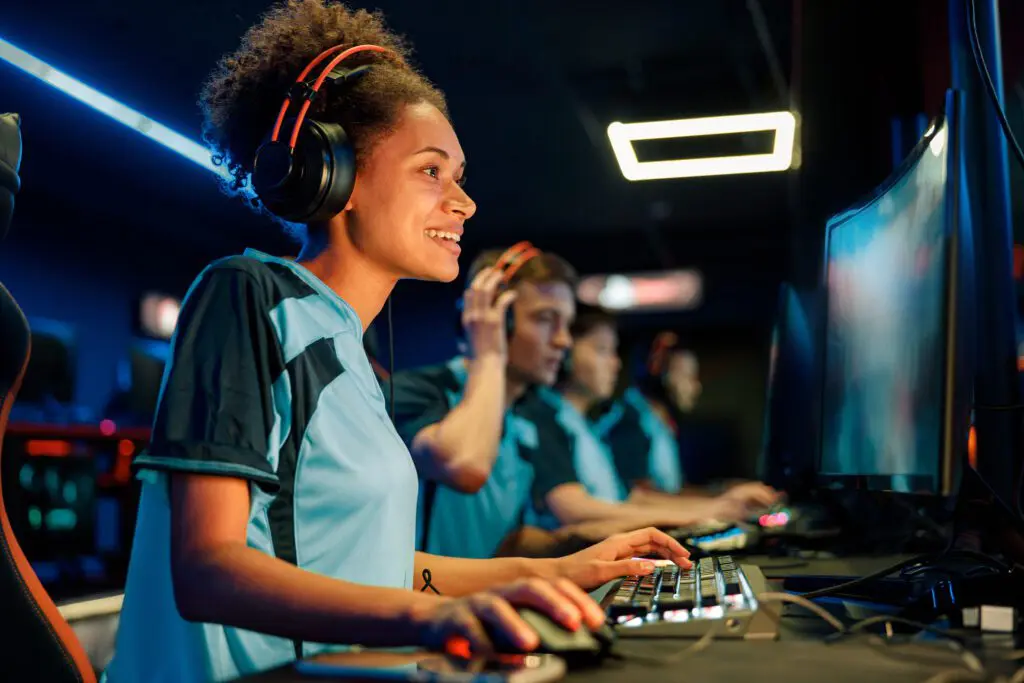Introducing blockchain technology is changing the way we as players interact and think about the gaming industry. In this article, we will explore the two main differences between Blockchain Gaming and Traditional Gaming and how web3 is shaping the industry and behaviours.
Firstly: Total ownership over gaming assets
In traditional gaming, we’ve always been acquiring skins (aesthetic items in games), whether it’s Fortnite character skins , Counter-Strike knife skins or League of Legends, you’re always buying digital items.

Blockchain gaming gives players ownership over their items, skins and progress
It was always one way – you put money into a game, but you’d never earn anything back. In traditional gaming, you can buy and own several items but you’ll never be its sole owner since other players will own exactly the same items.At the same time, traditionally, if you were to transition over to another game, you would have lost everything, there was no carryover or transmission. So you’d have to sell your whole account for money, giving up full ownership of coins, skins etc.
Blockchain brought ownership into the Gaming industry, allowing authentication and verification of items. Every skin and NFT is now living on the blockchain. An NFT is not necessarily just a skin, it could be a character, sword, body armor or land.Now you can literally just pack up and leave a game without necessarily having lost much. However, the assets could go down in value.
Secondly: The element of reward
Traditionally, you played a game and your reward was “fun” or “social recognition”. You literally had fun with your friends and got street cred. And that is essentially the point of playing video games.

Blockchain gaming gives players the power to earn and be rewarded.
If a player wanted to get paid for being the best, the only way was to join an esports team. The percentage of professional players to casual gamers is quite low. So only those at the very top are earning the most. And those at the bottom just enjoy playing the game without earning.It’s also a natural evolution because players have always sold their accounts. Runescape and Counter-Strike knife skins were always selling on the black market for real money, and more recently, some Elden Ring accounts got banned for selling in-game currency on eBay.Gamers have always managed to find ways to get rewarded for their time investment, but it’s never been fully accepted or integrated by game developers and has long been seen as a “black market” of sorts.
This still exists and some players do want to sell their in-game assets and make actual money that they can use to reinvest in the game or elsewhere. In blockchain gaming, this became a given. Every game now allows you to earn the in-game currency that you accumulate, which has real-life value since it is an actual cryptocurrency!For example, Thetan Arena has its $THC in-game reward token, while the famous Axie Infinity has $SLP, and so on.Every single game has its in-game token and economy which you can earn by playing, levelling up and trading assets. These in-game tokens can be used to upgrade your items, and reinvest to boost your characters – but they can also be withdrawn, similar to any cryptocurrency, and exchanged for stable coins or other cryptocurrencies.
However, blockchain integration could also mean losing all the fun in gaming, if it remains “play to earn”
With this new concept comes a downside of course. Taking the “fun” out of video games is a serious question mark that must be addressed within this space.
As certain developing areas continue to explore “play to earn” games as a source of income, many game studios have resorted to replicating previously winning formulas with little to no innovation.This now means some of these games lack game design, visuals or substantial content and, in general, are often not fun to play. They’re pretty much “click to earn”, completely defying the meaning and purpose of the first word in that sentence – play.

Like any game, blockchain games need to be fun – before anything.
This represents a danger since once in-game economies see a downtrend or a newer game comes out with a higher potential ROI – players tend to stop playing these games in question and move on to the next one, particularly during crypto market downtrends.
Where does gaming go from here?
In order to reach its full potential, the blockchain gaming space must introduce high-quality, unique and innovative games to prioritize fun and make earning secondary, so they hold value during the bearish periods and sustain a large, loyal player base.
At Polkastarter Gaming our ethos and vision for the future of this space is play AND earn. We believe that game design, competitiveness, innovative concepts and lore should always be the main focus of any gaming project, while still providing a sense of ownership and earning potential to reward its players.
One must not go without the other.
Join the PGG family today!

